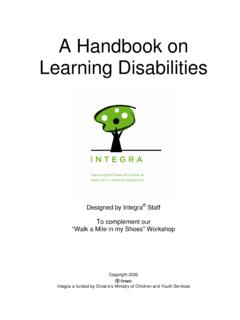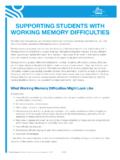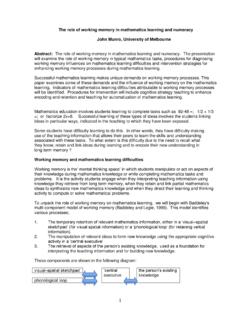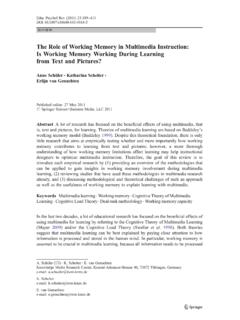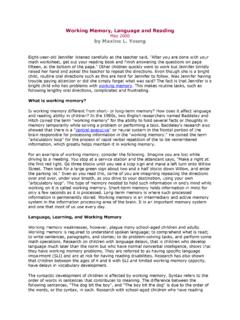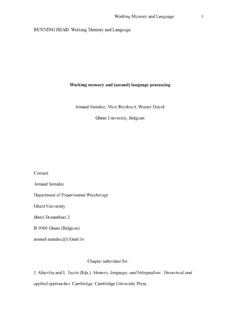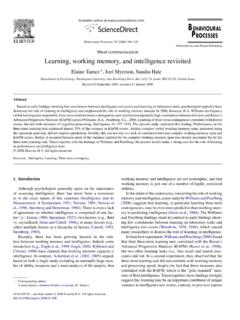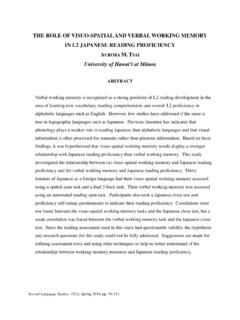Transcription of A Handbook on Learning Disabilities
1 A Handbook on Learning Disabilities Designed by Integra Staff To complement our Walk a Mile in my Shoes Workshop Copyright 2009 Integra is funded by Ontario s Ministry of Children and Youth Services Table of Contents 4 Introduction to 5 What are Learning Disabilities (LDs)? .. 5 How are LDs Identified? ..5 What Do LDs Affect? .. 5 How Common are LDs?.. 6 What Causes LDs?.. 6 What Helps?.. 6 Phonological Processing 7 Strategies for Helping Kids With Reading Difficulties .. 8 Language Processing Problems .. 9 Strategies for Helping Kids with Oral Language 9 Strategies for Helping Kids with Written Composition Difficulties .. 10 memory 11 Verbal memory .
2 11 working memory .. 12 Visual 12 Strategies for Helping Kids with working memory Difficulties .. 13 Strategies for Helping Kids with Instructions ..13 Visual-Spatial 15 Visual-perceptual 15 Visual-motor processing problems .. 15 Strategies for Helping Kids with Visual-motor Processing Difficulties:.. 16 Non Verbal Learning Disability (NLD) .. 17 What are the differences between NLD and AS?.. 17 General Strategies for Helping Kids with 18 Strategies for Helping Kids with NLD to Participate in Physical Activity .. 18 Strategies for Helping Kids with NLD to Socialize .. 18 Slow Processing Speed .. 19 Strategies for Helping Kids with Slow Processing .. 20 Executive 21 What are the differences between LDs with executive functioning problems and Attention Deficit Hyperactivity Disorder (AHDH)?
3 21 Strategies for Helping with Executive Functioning Difficulties .. 22 LDs and Mental Health .. 23 Strategies for Helping Self 23 Strategies for Helping Emotional Awareness and Control .. 23 Strategies for Helping Kids with Social Interactions .. 24 Strategies for Helping Communication Between Home, School and Other Settings .. 24 Homework tips:.. 25 Other Strategies to Help With Emotional Wellbeing .. 25 Understanding LDs: Putting it all 26 27 Books .. 27 Organizations .. 29 30 Videos .. 31 32 A Handbook on Learning Disabilities Designed by Integra Staff to Complement our Walk a Mile in My Shoes Workshop Copyright 2009 4 Foreword Integra is an accredited Children s Mental Health Centre leading in the treatment of vulnerable children and youth with Learning Disabilities (LDs).
4 Our agency s mission is to improve social, emotional and behavioral outcomes through a range of specialized, therapeutic, family-centered services, community education and research. We provide direct clinical services to children/youth with LDs and their families in Toronto, including individual, family and group counseling. Eligible to Ontario residents, Integra also operates Camp Towhee, a three-week residential summer camp for children and youth with LDs, located in Halliburton, Ontario. The Community Consultation Program at Integra was developed to promote a community-wide understanding of the mental health needs of children and adolescents who have Learning Disabilities . Through public education, workshops, staff training series and consultation, the program disseminates current information about Learning Disabilities and evidence-informed, best practice in related mental health fields.
5 Our aim is to dispel myths and improve societal attitudes toward individuals with Learning Disabilities . It is our position that widespread understanding of Learning Disabilities will contribute to healthier communities for children and families. This booklet is designed to complement participation in our flagship workshop, Walk a Mile in My Shoes . Adapted with permission from workshop ideas of Dr. Richard Lavoie, the Integra Walk-A-Mile workshop was originally developed by Dr. Barb Muskat. The workshop provided participants with an opportunity to experience the emotional impact of having Learning Disabilities while also gaining an understanding of the nature of the challenges. Over the years, the workshop has been continually updated and adapted to reflect state-of-the-art research about Learning Disabilities .
6 This booklet is intended to accompany the hands-on workshop to provide participants with additional knowledge about Learning Disabilities and suggestions for strategies when working with children and youth with Learning Disabilities . We welcome any questions or comments. For more information about Integra s Community Consultation Program including a list of upcoming workshops at 25 Imperial Street, Toronto or to book a workshop or training series for your school or agency, please contact Integra (416 486 8055, or visit our website ( ) Helen Hargreaves, MSW Community Consultation Coordinator Melissa Rowbotham, Manager of Community Consultation Marjory Phillips, , Director of Clinical Services & Community Consultation The Walk a Mile Work shop is funded by.)
7 Ontario s Ministry of Children and Youth Services And the generous support of individual donors A Handbook on Learning Disabilities Designed by Integra Staff to Complement our Walk a Mile in My Shoes Workshop Copyright 2009 5 Introduction to LDs What are Learning Disabilities (LDs)? LDs are a group of neurological or brain-based problems that affect one or more ways that a person takes in, stores or uses information. LDs come in many forms and their effects are different from person to person. They relate to: Getting information into the brain (Input) Making sense of this information (Organization) Storing and retrieving information ( memory ) Getting information back out (Output) How are LDs Identified?
8 By definition, people with LDs have average to above average intelligence yet they have very specific impairments in one or more of the psychological processes related to Learning . These processes may include: Language processing (understanding and expressing information using words) Visual-spatial processing (perceiving or organizing visual information) Visual-motor processing (carrying out hand-eye activities) Phonological processing (identifying and manipulating speech sounds) Processing speed (speed of taking in, using or pulling out information) working memory (holding information in mind while also using the information) Executive functions (planning and organizing) LDs are diagnosed most commonly as an outcome of a comprehensive psychological assessment.
9 Using a number of standardized tests that have been given to thousands of people, psychologists will systematically look at how people think, problem-solve, remember, understand and express information. What Do LDs Affect? LDs are a life-long condition that affects people differently depending on the situation. LDs can affect academic functioning, daily life and social life. For example, LDs can interfere with sight reading, reading comprehension, math, and writing. They can also interfere with organization, managing time, following multi-step instructions or interpreting graphs, charts and maps, for example. Some people with LDs have trouble interpreting facial expressions, understanding body language, understanding tones of voice or taking turns in conversations.
10 A Handbook on Learning Disabilities Designed by Integra Staff to Complement our Walk a Mile in My Shoes Workshop Copyright 2009 6 How Common are LDs? Learning Disabilities (LDs) are very common and affect 5 to 10 percent of Canadians. However, LDs vary greatly in form and intensity: No two LDs are the same. What Causes LDs? Learning Disabilities are due to genetic, other congenital and/or acquired neuro-biological factors. They often run in families. LDs are not caused by factors such as cultural or language differences, inadequate or inappropriate instruction, socio-economic status or lack of motivation, although any one of these and other factors may compound the impact of Learning Disabilities .
